
New Delhi
Large-scale mobilisation of green capital for investment and innovation in low-carbon energy solutions is the main holdout against a clean energy transition in emerging economies, according to an independent study released today by the CEEW Centre for Energy Finance (CEEW-CEF). More than USD 200 trillion worth of assets are under management in the world’s pension funds, insurance firms and sovereign wealth funds. Yet, the greatest challenge of our times – confronting climate change, especially in the most vulnerable countries – does not find enough suitors. India, alone, needs USD 2.5 trillion in climate financing by 2030. The upcoming UN Climate Action Summit, scheduled for 23 September, must demand committed action to build the conduits via which capital can flow from the Global North to the Global South.
The CEEW-CEF study comes just days after India’s Finance Ministry highlighted grave concerns over developing countries being denied their right to adequate financial resources for climate action. Despite rising low-carbon investment flows and slowly improving investor confidence in clean energy investments, the study demonstrates that there is a strong and stubborn link between the income levels of an economy and its energy investment. High-income countries, home to just over 15 per cent of the world’s population, accounted for more than 40 per cent of energy investment in 2018.
Emerging economies present a huge, and largely untapped, potential for investments in renewable energy and associated assets. However, a high perception of risk precludes international private and institutional capital from flowing into these economies at scale. As a result, in countries such as India, financing costs account for the largest component of renewable energy tariffs – between 50 and 65 per cent. The demand for energy and the demand for finance converge in emerging economies. As yet, global efforts to build a robust bridge between the supply and demand of green capital have failed.
Dr Arunabha Ghosh, CEO, CEEW, said, "As of now, lower-middle and low-income countries, which account for 40% of the world's population, get less than 15% of energy investment. This is because the cost of finance for renewable energy is extremely high for emerging economies and capital is not moving from capital-rich to capital-poor regions. While India has been averaging about USD 10.5 billion a year in clean energy investments, we need three times that number annually, just for the energy transition. To enable this, we need to have a more literate, more informed, and a more innovative conversation on climate finance and energy finance with the right actors. Without this, the trust deficit in climate finance will continue and the hope for enhanced ambitions for climate action will be dashed.”
Kanika Chawla, Director, CEEW-CEF, added, “In recent times, the consciousness for enhanced private investment consistent with a pathway towards low greenhouse gas emissions and climate-resilient development has been increasing. The challenge now is to convert the consciousness into conscious action and investment. A decade of inaction on climate finance has convinced emerging economies that one shade of green capital in the form of multilateral or bilateral development assistance is neither adequate nor forthcoming. Instead, different shades of green capital such as institutional investors, venture capitalists, private equity players, etc. need to find their way into diversified portfolios of projects, within across countries.”
The CEEW-CEF study makes three recommendations for facilitating enhanced flows of private capital from the Global North to the Global South. These include:
- Establishing a Climate and Clean Energy Finance Commission to accelerate the energy transition in emerging countries. The Commission could comprise climate and clean energy practitioners and thought leaders from the Global South, which would be convened to join existing task-forces on climate finance convened by the United Nations and beyond, to deliberate on the means of mobilising finance specifically for emerging markets.
- In order to facilitate learning between middle-income countries, the study recommends launching an Africa-India Clean Energy Co-Learnings Programme that would enable business-to-business exchanges between leading players in these markets. It would also result in the creation of a more aggregated market whereby emerging economies would have greater collective bargaining power as price-makers rather than price-takers.
- The study recommends reducing information asymmetries between clean energy project developers, on one hand, and prospective investors, on the other. The CEEW Centre for Energy Finance aims to do so and help deepen markets, increase transparency, and attract capital in the clean energy sectors of emerging economies.
About CEEW-CEF
The CEEW Centre for Energy Finance (CEEW-CEF) is an initiative of the Council on Energy, Environment and Water (CEEW), one of South Asia’s leading think tanks. CEEW-CEF acts as a non-partisan market observer and driver that monitors, develops, tests, and deploys financial solutions to advance the energy transition. It aims to help deepen markets, increase transparency, and attract capital in clean energy sectors in emerging economies. It achieves this by comprehensively tracking, interpreting, and responding to developments in the energy markets while also bridging gaps between governments, industry, and financiers.
Download a copy of the study below.
/articles/greening-new-pastures-green-investments